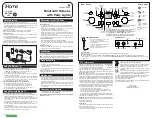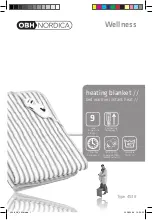
6
2. Description and connection
• The heating mat consists of the heating cable attached to a supporting fiberglass fabric.
• The heating cables should be connected to a 230 V, 50 Hz electrical network. Degree of protection: IP67.
• WTM mats have protective braiding. The cable’s protective braiding meets the standards required of metal grid
or metal shield and provides increased protection in spaces where that is required (bathroom, laundry, etc.) The
protective braiding is to be connected to the PE conductor or to a protective grounding connection.
• WTM mats have bottom- edge tapes that are adhesive on both sides. After removing the covering paper from
these tapes, the mat can be attached to the base.
• Fasten the connections and the head of the heating cable to the fabric by means of the attached tightening strip.
3. Installation
• First read Clause 1 of the General Terms and Conditions.
• Detailed descriptions of use for the individual materials can be found in the installation manuals for the re
-
commended materials.
PROCEDURE
• Unroll the heating mat and adjust it according to the area to be heated. Mark the place for the connection and ending of the heating mat on the floor. Roll the mat up again.
• Create “pockets” in the base material where you will place the connections for the heating and non- heating components.
• Clean the concrete area, remove any sharp objects and coat it using a suitable penetrating solution.
• Unroll the heating mat according to the area to be heated.
• Remove the protective covering from the self- adhesive tapes and attach the mat to the base.
• Measure the resistance of the heating circuit and the insulation resistance and record the measured values in the certificate of warranty.
• Use flexible adhesive sealing cement and a flat spreader to smooth the floor surface (be careful not to damage the cable with the sharp edge of the spreader).
• Before laying the floor tiles, measure the heating circuit values again and record both values in the certificate of warranty.
• Lay the floor tiles onto the surface.
• When putting the heating mat into operation, the adhesive sealing cement must be fully hardened (see instruction for use and recommendation from material’s manufacturer).
SECTIONAL VIEW OF THE FLOOR – new constructions
1. Floor tiles
2. Flexible adhesive sealing cement
3. WTM heating mat
4. Installation pipe with a floor probe
5. Concrete spread layer 40mm
6. Reinforcing steel grid (KARI)
7. Thermal insulation min. 70–80mm
8. Base
SECTIONAL VIEW OF THE FLOOR – reconstruction
1. New floor tiles
2. Flexible adhesive sealing cement
3. WTM heating mat
4. Installation pipe with a floor probe
5. ISLOLA thermal insulation (optional)
6. Flexible adhesive sealing cement l
7. Original floor tiles or another base
4. Regulation
For regulation, use one of currently available thermostats.
• For floors where exceeding the hygienic limit of 27°C is not anticipated, or for floors in rooms occupied for only short intervals (bathroom, lavatory, corridor) with surface area out
-
put of up to 160W/m
2
, it is optional to use the thermostat’s limiting floor probe. For all other applications, the thermostat must be equipped with a floor probe with the maximum
temperature set to 35°C.
5. Accelerating the warming of heating floors
• We recommend putting the mat into operation after 5 days from laying the final layer of the floor (floor covering).
Note: The values mentioned above are for information only, it is necessary to follow the instructions provided by the
manufacturer of the respective construction material.
4. Warranty, claims
supplier of the cable circuits, provides a warranty period of 10 years for the product’s functionality, beginning from the date of its installation that is confirmed in the certificate of
warranty (installation must be made at latest within 6 months from the date of purchase), provided that:
• a certificate of warranty and proof of purchase are submitted,
• the procedure described in this user guide has been followed,
• data on laying and connecting the cable in the floor and the resulting measured values of the insulation resistance of the heating cable are provided, and
• the procedure for applying the sealing cement specified by its producer has been followed.
Claims may be made in writing at the company that performed the installation, or directly to the manufacturer.


































